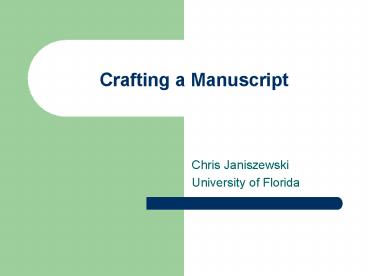Crafting a Manuscript PowerPoint PPT Presentation
1 / 27
Title: Crafting a Manuscript
1
Crafting a Manuscript
- Chris Janiszewski
- University of Florida
2
A Successful Manuscript Depends On
- The underlying contribution.
- The competence of the research.
- The clarity of the writing.
3
A Successful Manuscript Depends On
- The underlying contribution.
- The competence of the research.
- The clarity of the writing.
4
The Contribution Topic
- Trees of Knowledge
- Trees are areas of inquiry.
- Your goal is to accurately describe the tree
(where description is the documentation of the
process).
5
The Contribution Topic
Knowledge generation depends on assumptions.
Area Assumptions (e.g., priming, interference)
Foundation Assumptions (e.g., memory is
associative)
Metaphor Assumptions (e.g., memory is an entity)
6
The Contribution Topic
Contributions document process contingent on
these underlying assumptions.
Existing Contributions
Area Assumptions (e.g., priming, interference)
Foundation Assumptions (e.g., memory is
associative)
Metaphor Assumptions (e.g., memory is an entity)
7
The Contribution Topic
Proposed Contributions
8
The Contribution Topic
Proposed Contributions
Intuitive
9
The Contribution Topic
Proposed Contributions
Intuitive
10
The Contribution Topic
Proposed Contributions
Trivial
Intuitive
11
The Contribution Topic
Proposed Contributions
Trivial
Intuitive
12
The Contribution Topic
Proposed Contributions
Narrow
Trivial
Intuitive
13
The Contribution Topic
Proposed Contributions
Narrow
Trivial
Interesting Idea!
Intuitive
14
Relevance for Writing
Area Assumptions (e.g., priming, interference)
Novel Assumptions (e.g., suppression)
Foundation Assumptions
Metaphor Assumptions
15
Relevance for Writing
Reviewers
Area Assumptions (e.g., priming, interference)
Novel Assumptions (e.g., suppression)
Foundation Assumptions
Metaphor Assumptions
16
A Successful Manuscript Depends On
- The underlying contribution.
- The competence of the research.
- The clarity of the writing.
17
Clarity of Writing
- Will focus on the
- Communication goals of the manuscript.
- Organization of the manuscript.
- Content (i.e., too much, too little) of the
manuscript. - Will not focus on grammar or style (JCR has a
great style sheet http//wiscinfo.doit.wisc.edu/j
cr/newstylesheet.pdf - Caveats
- Will adopt an experimental orientation.
- Will pick the low lying fruit.
- There are many ways to write an effective
manuscript (examples ? template). - Interactive (Audience needs to ask the How come
? questions).
18
General Recommendation Make your paper easy to
read
- Create and fulfill expectations.
- Terminology Be consistent, provide definitions.
- If affect transfer associative response
response generalization, then pick one term. - If prime ? facilitate ? polarize, then
define terms an use appropriately. - Headings Use headings to keep the reader
organized. - Paragraph Structure Use a common format across
paragraphs in a section. - In theoretical review general finding, sample
study and results, implications - In results section list topic or hypothesis,
2-way test, simple main effect tests,
interpretation (repeat by variable, study)
19
Specific RecommendationsSection-by-section
organization
- Introduction
- Theoretical background
- Procedure and results
- Discussion
- Post-draft improvements
20
The IntroductionFrame the research and sell the
idea
- Paragraph 1 Convey that the topic is interesting
/ important. - Paragraph 2/3 Identify the gap / inconsistency
in the literature and state the intended
contribution. - Paragraph 2/3 Establish relevant assumptions
(properly orient the reader). - Paragraph 2/3 Define relevant terminology.
- Paragraph 3 Provide specific details about the
contribution (sell idea to the reader).
21
Theoretical Review Section Provide Necessary
Background
22
Procedure
- There is considerable variability in format.
- Opening paragraph(s)
- Contribution, experimental context, expected
results. - Method
- Make sure reader has template for organizing the
information. - Provide examples (novices use exemplars to aid
comprehension). - Provide the detail required by a critical
reviewer streamline after first review.
23
Results
- Organize according to readers expectations
(i.e., H1, H2, H3). - Report analyses from complex (e.g., three-way
interaction) to simple (e.g., simple effect
tests). - Provide means and statistics that allow the
reader to link the text information to the table
/ graph. - Use a consistent reporting format (common terms,
sentence structure, sentence organization).
24
Results Red Flags
- Means in text do not match means in tables.
- Test statistics are not reported or test
statistics are not linked to means. - Data are selectively analyzed (e.g., 1/3 of
sample or 1 of 2 dependent measures) - Unexpected tests are reported (to account for
unexpected results). - Pet Peeve Terminology / variable order in text
does not match terminology / variable order in
table / graph.
25
Discussion / Transition
- Communicate key results of study (paragraph 1).
- Discuss and discount alternative hypotheses.
- Set agenda for next study.
- Motivate next study.
- Reader should feel that next study is an obvious
next step (i.e., dont want reader thinking,
but I would have ). - Theory background and discussion section jointly
establish expectations.
26
General Discussion
- Summarize key results Be honest
- Implications Averaging, not adding
- Claims Be respectful (recognize boundary
conditions) - Claims Be humble
- Future research One concisely discussed idea is
better than a multitude of loosely developed
thoughts.
27
Post-writing Improving the manuscript
- Set manuscript aside. Then, review and rewrite.
- Do all of the pieces fit?
- Can positioning / review / process explanation be
improved? - Once a final draft is completed, spend a day or
two on style. - Word choice and word consistency.
- AMA, JCR, or APA style sheet.
- Use friendly reviewers strategically.

